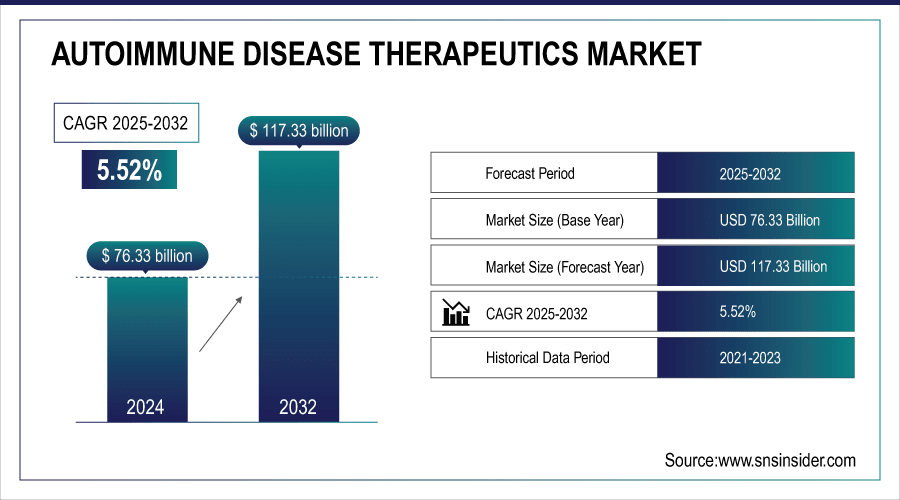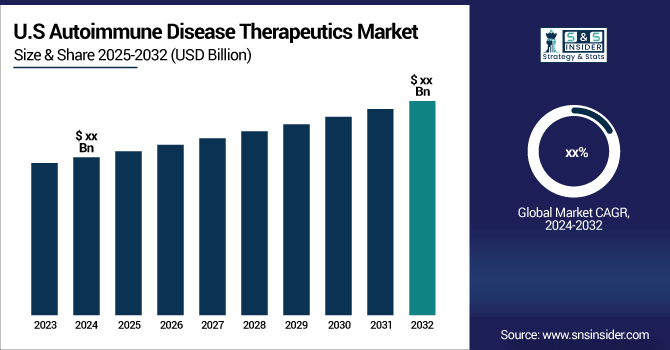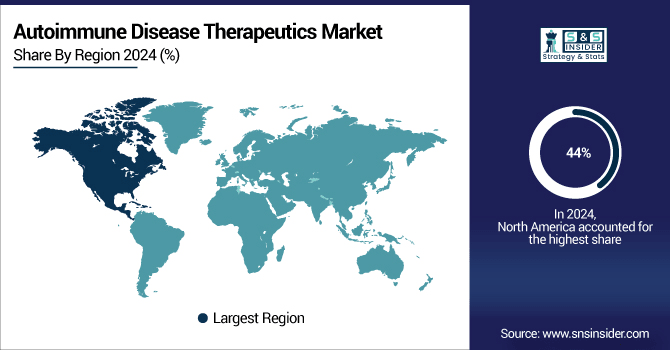Autoimmune Disease Therapeutics Market Overview
The Autoimmune Disease Therapeutics Market was valued at USD 76.33 billion in 2024 and is expected to reach USD 117.33 billion by 2032, growing at a CAGR of 5.52% from 2025-2032.
The Autoimmune Disease Therapeutics Market is experiencing strong growth, fueled by the rising prevalence of conditions like rheumatoid arthritis, lupus, and multiple sclerosis. Advances in biologics and biosimilars are transforming treatment by offering precise mechanisms of action and improved patient outcomes. Growing healthcare spending, coupled with increased NIH research funding, is accelerating the adoption of innovative therapies such as monoclonal antibodies and JAK inhibitors. Looking ahead, AI and precision medicine, including Penn State’s 2024 EXPRESSO algorithm, along with breakthroughs in gene therapy and novel delivery systems, are set to revolutionize patient care and expand market opportunities.
According to the NIH, the global incidence of autoimmune diseases is rising annually by 19.1%, while prevalence increases by 12.5%, highlighting an urgent healthcare challenge.
The National Institutes of Health significantly boosted funding for autoimmune disease research, increasing investments from USD 800 million to over USD 1 billion in fiscal year 2022.
In May 2024, researchers at Penn State introduced EXPRESSO, a groundbreaking AI algorithm designed to improve prediction and treatment of autoimmune diseases, accelerating drug discovery and patient care.

To Get More Information On Autoimmune Disease Therapeutics Market - Request Free Sample Report
Autoimmune Disease Therapeutics Market Trends
Key trends shaping the autoimmune therapeutics market include:
-
Rising prevalence of autoimmune disorders is fueling demand for advanced therapeutic solutions.
-
Biologics and targeted therapies are gaining traction for improved treatment outcomes.
-
Growing focus on personalized medicine is shaping therapeutic development.
-
Increasing R&D investments and clinical trials are accelerating innovation in drug pipelines.
-
Expanding adoption of biosimilars is enhancing accessibility and affordability of treatments.
-
Collaborations between pharma companies and research institutions are driving new product development.
-
Rising patient awareness and improved diagnostic capabilities are boosting early treatment adoption.

Autoimmune Disease Therapeutics Market Growth Drivers
Advancements in Biotechnology
The development of monoclonal antibodies, biologics, and gene therapies has transformed the landscape of autoimmune disease management, offering more targeted and effective treatment options. These advanced therapies specifically target the underlying mechanisms of diseases, providing better outcomes compared to traditional treatments. Biologics, in particular, have emerged as the cornerstone of autoimmune disease treatment, offering improved efficacy and fewer side effects. Additionally, the growing focus on gene therapies and personalized medicine holds great promise for future treatment advancements. These innovations are not only improving patient outcomes but are also expanding market opportunities for biotech and pharmaceutical companies globally, contributing to the rapid expansion of the autoimmune disease therapeutics market.
Emergence of Personalized Medicine
The rise of personalized and precision medicine is revolutionizing the autoimmune disease therapeutics market by offering tailored treatments based on an individual’s unique genetic makeup and disease profile. This approach allows for more targeted therapies, improving treatment effectiveness and minimizing side effects, which significantly enhances patient outcomes. By analyzing genetic, environmental, and lifestyle factors, healthcare providers can create customized treatment plans that address the root causes of autoimmune conditions. As the demand for more efficient, patient-specific therapies grows, pharmaceutical companies are increasingly investing in personalized medicine, driving innovation and market expansion. This shift towards individualized care is helping to optimize therapeutic efficacy, reduce healthcare costs, and boost the overall growth of the autoimmune disease therapeutics market, creating vast opportunities for both research and commercialization.
Market Restraints and Challenges
Side Effects and Safety Concerns Hinder Growth of Autoimmune Disease Therapeutics Market
Biologic and immunosuppressive therapies, while highly effective in treating autoimmune diseases, come with notable risks that can influence patient decisions and market growth. These advanced treatments often carry side effects such as increased susceptibility to infections, organ damage, and allergic reactions. For instance, biologics can suppress the immune system, leaving patients more vulnerable to opportunistic infections, while the prolonged use of immunosuppressive drugs can result in complications like liver damage. These safety concerns may lead to patients avoiding or discontinuing treatment, particularly when safer, more traditional options are available. Furthermore, the need for regular monitoring to manage these risks adds a burden on healthcare systems, limiting the widespread adoption and growth of these therapies in the autoimmune disease market.
Autoimmune Disease Therapeutics Market Segment Highlights
-
By Sales Channel, Hospital Pharmacy dominated with 54% share in 2024; Online Store fastest growing (CAGR 8.04%).
-
By Indication, Rheumatic Disease dominated with 43% share in 2024; Inflammatory Bowel Disease fastest growing (CAGR 8.99%).
-
By Drug Class Type, Anti-inflammatory dominated with 43% share in 2024; fastest growing (CAGR 8.99%).
Autoimmune Disease Therapeutics Market Segment Analysis
By Sales Channel Hospital Pharmacy led while Online Store is expected to grow fastest
The Hospital Pharmacy segment led the Autoimmune Disease Therapeutics Market in 2024. This dominance is driven by the critical role hospitals play in managing complex autoimmune treatments, where specialized therapies like biologics and immunosuppressants are administered. Additionally, hospitals provide direct access to healthcare professionals and monitoring, ensuring optimal patient care. This makes the hospital setting the preferred choice for advanced autoimmune disease therapies.
The Online Store segment is expected to grow at the fastest CAGR from 2025 to 2032. The growth is fueled by the increasing shift toward e-commerce, offering convenient access to autoimmune therapeutics. Telemedicine’s rise and the growing preference for home delivery of medications have boosted online pharmacy sales. As digital healthcare solutions expand, more patients are turning to online stores for their treatment needs.

By Indication Rheumatic Disease dominated while Inflammatory Bowel Disease is projected to grow fastest
The Rheumatic Disease segment led the Autoimmune Disease Therapeutics Market in 2024. This dominance is driven by the high prevalence of rheumatoid arthritis and other rheumatic conditions. The growing demand for advanced biologics and disease-modifying antirheumatic drugs has solidified its position. Additionally, ongoing innovations in targeted therapies have further strengthened this segment's market leadership.
The Inflammatory Bowel Disease segment is expected to grow at the fastest CAGR from 2025 to 2032. This growth is fueled by the rising incidence of Crohn’s disease and ulcerative colitis, alongside increasing demand for biologic therapies. Advances in personalized medicine and early diagnosis are enhancing treatment effectiveness, making IBD the fastest-growing segment in the autoimmune therapeutics market.
By Drug Class Type Anti-inflammatory segment led while it is expected to grow fastest
The Anti-inflammatory segment dominated the Autoimmune Disease Therapeutics Market in 2024 and is expected to grow at the fastest CAGR from 2025 to 2032. This dominance is driven by the widespread use of anti-inflammatory drugs, particularly corticosteroids, non-steroidal anti-inflammatory drugs, and biologics, which are essential in managing autoimmune conditions like rheumatoid arthritis, psoriasis, and lupus. As the global prevalence of these diseases continues to rise, the demand for effective anti-inflammatory treatments is increasing. Moreover, ongoing advancements in biological therapies and the development of targeted anti-inflammatory drugs are driving the segment's robust growth, positioning it for continued expansion in the coming years.
Regional Analysis
North America Autoimmune Disease Therapeutics Market
North America dominated the Autoimmune Disease Therapeutics Market in 2024, capturing approximately 44% of the revenue share. This dominance is primarily attributed to the high prevalence of autoimmune diseases, advanced healthcare infrastructure, and strong reimbursement policies in the region. The presence of leading pharmaceutical companies, extensive research and development efforts, and the adoption of cutting-edge biologic therapies further solidify North America's market leadership.

Get Customized Report as Per Your Business Requirement - Enquiry Now
Asia Pacific Autoimmune Disease Therapeutics Market
In contrast, the Asia Pacific region is expected to grow at the fastest CAGR of 7.25% from 2025 to 2032. This growth is driven by the increasing incidence of autoimmune diseases and improving healthcare access across emerging economies. Rising awareness, enhanced diagnostic capabilities, and the growing adoption of biologics and personalized treatments are contributing to the rapid market expansion in the region. As healthcare infrastructure continues to improve, Asia Pacific is positioned to become a key growth driver in the autoimmune disease therapeutics market.
Europe Autoimmune Disease Therapeutics Market
Europe holds a significant position in the Autoimmune Disease Therapeutics Market, driven by high disease prevalence, advanced healthcare infrastructure, and strong R&D initiatives. Widespread adoption of biologics, biosimilars, and targeted therapies is supported by government programs and growing healthcare expenditure. Increasing investments in precision medicine, clinical trials, and AI-driven treatment approaches are further strengthening Europe’s market growth and innovation landscape.
Middle East & Africa and Latin America Autoimmune Disease Therapeutics Market
The Middle East & Africa and Latin America are emerging markets in autoimmune disease therapeutics, propelled by rising disease awareness, improving healthcare infrastructure, and increasing access to advanced treatments. Growing adoption of biologics and biosimilars, coupled with supportive government initiatives and expanding R&D activities, is driving market growth. Enhanced healthcare spending and regional collaborations are further accelerating therapeutic accessibility and innovation.
Autoimmune Disease Therapeutics Market Competitive Landscape:
Bristol-Myers Squibb
Bristol Myers Squibb is a key player in the Autoimmune Disease Therapeutics Market, offering therapies such as Orencia and Zeposia for conditions like rheumatoid arthritis and multiple sclerosis. The company focuses on biologics and targeted immunomodulators to improve patient outcomes, manage chronic symptoms, and enhance quality of life. Strong R&D capabilities and strategic collaborations support its development of advanced therapies, strengthening its market presence globally.
-
In 2024, Bristol Myers Squibb is advancing CAR T-cell therapy for autoimmune diseases like lupus and multiple sclerosis, aiming to provide innovative, long-term treatment options with potential to "reset" the immune system.
Novartis
Novartis is a prominent contributor to the Autoimmune Disease Therapeutics Market, offering therapies like Cosentyx and Ilaris for autoimmune conditions such as psoriasis, rheumatoid arthritis, and multiple sclerosis. The company emphasizes biologics and targeted treatments that improve patient outcomes, reduce disease progression, and enhance quality of life. Its strong pipeline, ongoing clinical trials, and investment in innovative therapies reinforce its leadership in advanced autoimmune disease management.
-
In September 2024, Novartis announced that Kesimpta (ofatumumab) showed long-term benefits for relapsing multiple sclerosis (RMS) patients, with nearly 90% of first-line patients experiencing no disability progression for up to six years, emphasizing the advantages of early treatment.
KEY PLAYERS
-
Bristol-Myers Squibb Company
-
F. Hoffmann-La Roche Ltd. (Genentech, Inc.)
-
Novartis AG
-
Abbott Laboratories(Humira [pre-spin-off], FreeStyle Libre)
-
Amgen Inc.
-
Johnson & Johnson
-
AstraZeneca Plc
-
UCB S.A.
-
Biogen Idec Inc.
-
Chugai Pharmaceutical Co. Ltd.
-
Danaher
-
Bayer Schering Pharma AG
-
Elan Corporation Plc
-
Eli Lilly and Company
-
GlaxoSmithKline Plc
-
HYCOR Biomedical
-
Merck & Co. Inc.
-
Horizon Therapeutics Plc
| Report Attributes | Details |
|---|---|
| Market Size in 2024 | USD 76.33 Billion |
| Market Size by 2032 | USD 117.33 Billion |
| CAGR | CAGR of 5.52% From 2025 to 2032 |
| Base Year | 2024 |
| Forecast Period | 2025-2032 |
| Historical Data | 2021-2022 |
| Report Scope & Coverage | Market Size, Segments Analysis, Competitive Landscape, Regional Analysis, DROC & SWOT Analysis, Forecast Outlook |
| Key Segments | • By Drug Class (Anti-inflammatory, Antihyperglycemics, NSAIDs, Interferons, Others) • By Indication (Rheumatic Disease, Type 1 Diabetes, Multiple Sclerosis, Inflammatory Bowel Disease, Other Indications) • By Sales Channel (Hospital Pharmacy, Drug Store & Retail Pharmacy, Online Store) |
| Regional Analysis/Coverage | North America (US, Canada, Mexico), Europe (Eastern Europe [Poland, Romania, Hungary, Turkey, Rest of Eastern Europe] Western Europe] Germany, France, UK, Italy, Spain, Netherlands, Switzerland, Austria, Rest of Western Europe]), Asia Pacific (China, India, Japan, South Korea, Vietnam, Singapore, Australia, Rest of Asia Pacific), Middle East & Africa (Middle East [UAE, Egypt, Saudi Arabia, Qatar, Rest of Middle East], Africa [Nigeria, South Africa, Rest of Africa], Latin America (Brazil, Argentina, Colombia, Rest of Latin America) |
| Company Profiles | Pfizer Inc., Bristol-Myers Squibb Company, F. Hoffmann-La Roche Ltd. (Genentech, Inc.), Novartis AG, Abbott Laboratories, AbbVie Inc., Amgen Inc., Johnson & Johnson, AstraZeneca Plc, UCB S.A., Biogen Idec Inc., Chugai Pharmaceutical Co. Ltd., Danaher, Bayer Schering Pharma AG, Elan Corporation Plc, Eli Lilly and Company, GlaxoSmithKline Plc, HYCOR Biomedical, Merck & Co. Inc., Horizon Therapeutics Plc |

